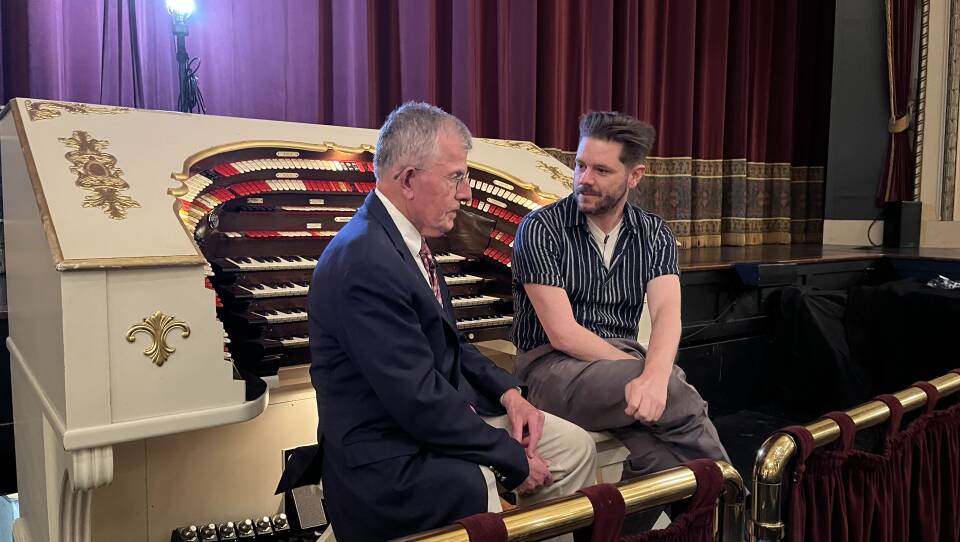In the history of American culture, few sounds are as closely tied to the idea of entertainment as the theater pipe organ. At once nostalgic and timeless, it is often referred to as “the king of instruments” for its size, as well as the virtuosic talent required to play it well. And in the world of theater organs, one name reigns supreme — the Mighty Wurlitzer.
“Every time I sit at this instrument, it’s almost as good as romance,” says Jonathan Kleefield, resident organist at the Hanover Theatre and Conservatory for the Performing Arts in Worcester. “There is a visceral sense of excitement having at the control of your fingertips something as magisterial and beautiful as this instrument.”
Wurlitzers are a product of a unique period of American cinematic history: the era of the silent picture. Providing the sound of a full orchestra without the expense was the magic of the Wurlitzer — and its rise in popular culture was meteoric.
“By 1915, the first theater organ was installed in a theater in Seattle and it was an immediate success,” said Kleefield. In the early 20th century, thousands of these gigantic pipe organs were installed in movie theaters throughout the United States, Canada, England and Australia to accompany silent movies. But the Wurlitzer’s reign as the undisputed “king of instruments” was brief.
“And then comes the famous phrase, ‘You ain’t heard nothing yet,’” laments Kleefield. When Al Jolson uttered those words in the 1927 film “The Jazz Singer,” they rang out like a death knell, effectively ending the commercial viability of the theater pipe organ.
As the popularity of the Wurlitzer cratered, many of these mighty pieces of craftsmanship were lost to history. Thousands were ripped from theater walls to make space for newer enticements. Many were left to disintegrate in landfills.
However, a passionate — almost fanatical — community of theater organ enthusiasts has taken up the mantle of preservation for the mighty Wurlitzer. One such person is Don Phipps. He has spent decades accumulating the spare parts necessary to rehabilitate one of these organs.
“These instruments have a soul,” Phipps said. “They were designed to couple between what was seen on the screen and generate the emotions as required with the plot of the movie in the heart and souls of the audience.”
His restoration effort required a Groton warehouse to serve as the instrument’s temporary home. All that was left was to find the perfect venue. He reached out to the Hanover Theatre.
“The mighty Wurlitzer organ has been a part of the theater since the beginning of the Hanover Theatre’s inception,” said Annie Kerins, the venue’s public relations manager. “The wonderful Don Phipps brought it to the attention of the founders and the artistic director of the theater, and basically said, 'I have this wonderful, amazing instrument… What about this theater that you’re about to renovate?’”
The thing about pipe organs is that they’re huge. In order for the instrument to be experienced properly, thousands of feet of pipes are built into the walls and crevices and caverns of whatever venue houses it, with masses of wires connecting the console to the pipe chambers. The construction of each organ requires the expertise of electricians, woodworkers and pipe makers to bring the majestic sound to life.
And it requires regular upkeep, too. At the Hanover Theatre, the entire organ maintenance team is made up of volunteers.
“This organ has about 2,500 pipes in it, plus a whole bunch of tuned percussion,” explained Bruce Hager, volunteer curator of the organ. “It’s a wonderful musical instrument, but it’s also a huge machine. There are thousands of moving parts and several thousands of components of the chambers.”
“I wouldn’t mind being called crazy about something like this, because I am,” said Kleefield, the Hanover’s resident organist. “It is an absolute highlight of my life.”
To some, the theater organ is no more than a vestige of a time long gone. But if you listen to one close enough, you might hear something more timeless: pure, unadulterated fun.
“I’m 91 years old today. I drove 73 miles, and there isn’t anything I’d rather do than come out here and listen to Maestro Kleefield,” said Phipps. “When you think about your twilight years and if you could choose anything you’d want to do, you know. … I’m doing it.”
And it’s exactly that kind of love that keeps the Mighty Wurlitzer mighty.
You can attend “America the Beautiful: A Patriotic Musical Review” Sept. 11 at the Hanover Theater in Worcester. The program will begin at 12 p.m., and will include marches, melodies and folk tunes. Tickets are $10 for non-members and free for subscribers, current conservatory families, members and their guests. For more information, please visit thehanovertheatre.org.






